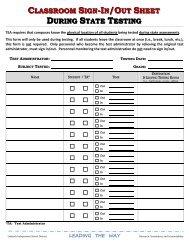Guidelines for Co-Teaching in Texas - Region 17
Guidelines for Co-Teaching in Texas - Region 17
Guidelines for Co-Teaching in Texas - Region 17
Create successful ePaper yourself
Turn your PDF publications into a flip-book with our unique Google optimized e-Paper software.
Figure 6: When <strong>Co</strong>-Teachers DisagreePr<strong>in</strong>cipals and other site adm<strong>in</strong>istrators have an important responsibilityto be sure that co-teachers beg<strong>in</strong> the year <strong>in</strong> a positive way and growtheir practice so that student success <strong>in</strong>creases.They can do this by:• Visit<strong>in</strong>g co-taught classes several times dur<strong>in</strong>g the first month of school, not<strong>in</strong>gwhether both teachers are teach<strong>in</strong>g, how students are respond<strong>in</strong>g to bothteachers, and what teach<strong>in</strong>g strengths and weakness are displayed;• Meet<strong>in</strong>g with all co-teachers early <strong>in</strong> the school year to discuss exemplary practiceand to encourage cont<strong>in</strong>ued growth; and/or• Meet<strong>in</strong>g with specific sets of partners if it seems a problem exists <strong>in</strong> the<strong>in</strong>struction, behavior/classroom management, or partnership.If a conflict arises and persists, one or more of thesestrategies may be helpful:• Speak to each teacher <strong>in</strong>dividually and then together to identify issue(s),air them, and problem-solve to identify compromises or solutions;• Ask a school professional who does not supervise the teachers (e.g., counselor,psychologist) to have the problem-solv<strong>in</strong>g conversations with the teachers whodisagree; and/or• Observe the co-teach<strong>in</strong>g to identify how the conflict may be affect<strong>in</strong>g studentlearn<strong>in</strong>g. Frame the conversation around that topic.These strategies are NOT recommended:• Rely<strong>in</strong>g on the perspective of just one teacher regard<strong>in</strong>g the conflict;• Decid<strong>in</strong>g to halt the co-teach<strong>in</strong>g; this is a problem because students mustreceive their services, and they must occur <strong>in</strong> the least restrictive environment;and/or• Decid<strong>in</strong>g to move the students and special educator to a different generaleducation class; this may send a message that if there is disagreement,co-teach<strong>in</strong>g will be abandoned. Send<strong>in</strong>g this unfavorable message may,over time, encourage reluctant teachers to resist co-teach<strong>in</strong>g.24 | <strong>Texas</strong> <strong>Co</strong>-<strong>Teach<strong>in</strong>g</strong> <strong>Guidel<strong>in</strong>es</strong> <strong>Texas</strong> Education Agency / Education Service Center, <strong>Region</strong> 20
















